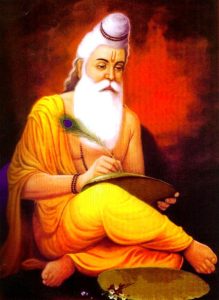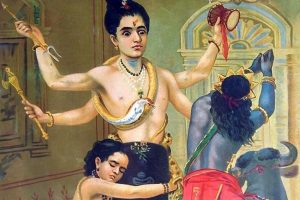Yoga in the Puranas
 The Puranas are a group of sacred writings which contain a wealth of mythological, historical, philosophical, ritualistic, scientific and not least yogic traditions. Ideally a Purana – the word means ‘ancient’ –should deal with five topics:
The Puranas are a group of sacred writings which contain a wealth of mythological, historical, philosophical, ritualistic, scientific and not least yogic traditions. Ideally a Purana – the word means ‘ancient’ –should deal with five topics:
- sarga – creation
- pratisarga – dissolution
- vamsa – genealogy (of gods and saints)
- manvantara –description of the word – ages
- vamsa –anucarita – genealogy of kings
Most of the important puranas deal with Yoga in a more or less detailed manner, e.g. the Visnu, Bhagavata, Markandeya, Agni, Matsya, Garuda, Siva, Bhagavata, Markandeya and the Garuda Purana.
Siva Purana
The Siva purana speaks of three types of yogis who worship Siva:
- kriya yogi – who is engaged in sacred rites
- tapo yogi – who desists from hurting others and practices sense withdrawal and also performs various kinds of worship;
- Japa yogi – who always performs japa (recitation) and is free from all desires and maintains all the observances of the other two types as well. Japa is practised with the five syllable mantra of Siva: namah Sivaya, homage to Siva.
Elsewhere in this text five divisions of yoga are mentioned:
- mantra yoga – concentration on the meaning of the mantra
- sparsa yoga – as above plus the practice of the control of the life force (pranayama)
- bhava yoga – the recitation of the mantra is dropped
- abhava yoga – the universe is contemplated
- maha yoga – the nature of Siva is contemplated.
Bhagavata Purana
The yoga enunciated in the Bhagavata Purana follows closely the theistic line of the Bhagavad Gita. Yoga is primarily the wholehearted contemplation of the supreme Narayana or Krsna, who is considered the supreme refuge of yoga. Krsna is depicted as outlining the method of this yoga. From this description it is evidence that this particular teaching incorporates a good deal of breathing techniques, characteristic of most tantric forms of yoga. A triple yoga is taught: jnana is valuated higher than karma which is meant for all those who have not yet acquired perfect distaste for worldly objects.
Markandeya Purana
Yoga is also dealt with in the Markandeya purana which speaks in detail about the qualities of a person suitable for yoga and the environmental conditions necessary of success in its practice. The body is recognized as an important instrument for making spiritual progress. According to the text the mark of perfection in yogi is that sat in which no being fears him, nor does he fear others. The yogis are subdivided according to the predomi  nance of either of the three gunas. They are also distinguished by their achievement on the path.
nance of either of the three gunas. They are also distinguished by their achievement on the path.
- pratibha – stage – the yoga comprehends all the sacred scriptures and others branches of knowledge
- sravanda – stage – he known all the whorls and their meaning
- daiva – stage – he perceives everything including the deities
- bhrama – stage – his mind is fickle and without proper support which impedes his progress.
